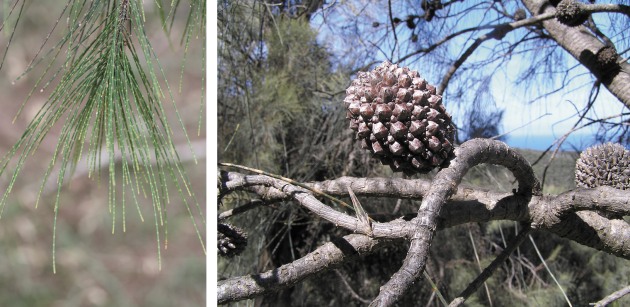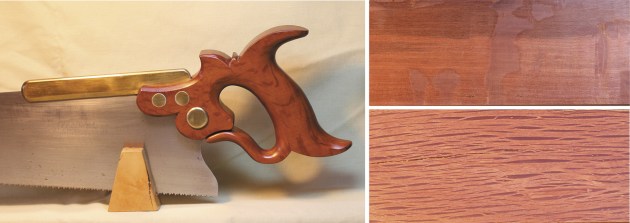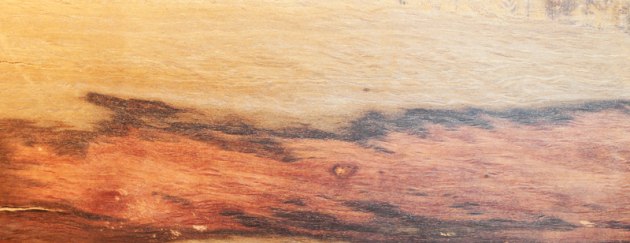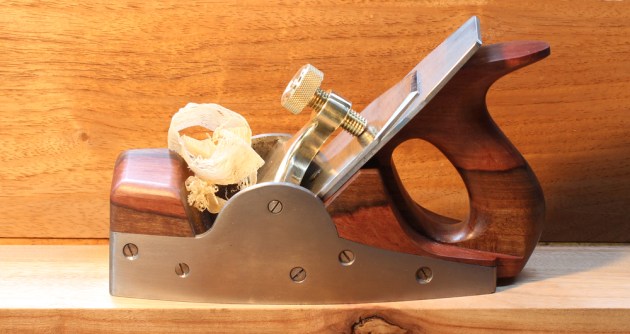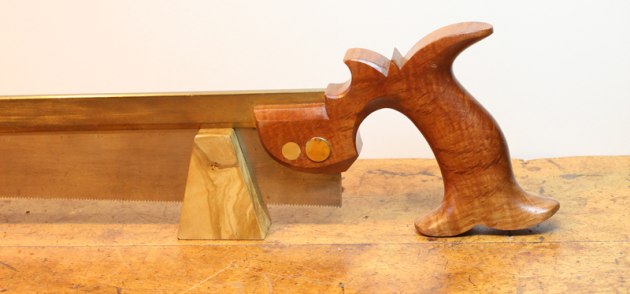In praise of casuarinas
Words and photos: Ian Wilkie
Names and misnomers
There are many interesting Australian woods that are not generally available commercially, and most casuarinas (sheoaks) fall into this category. ‘Sheoaks’ were once all lumped under the one generic name of casuarina, but have been recently split into three different genera. The ones that are familiar to many of us have now mostly become Allocasuarina (Allo means different).
1. The needles of casuarinas are really branchlets, with the leaves reduced to whorls of tiny ‘teeth’. 2. The cones of drooping sheoak (A. vertillata), can be up to 50mm long.
Many books and reference sources have not yet caught up with the name changes, so I will use casuarinas as a lumping term, and Allocasuarina for the botanical name where I’m reasonably sure it is the currently accepted name. Incidentally, the name casuarina comes from the Latin name for cassowaries (Casuarius spp.) because the drooping foliage (photo 1) looks like the feathers of a cassowary.
3. Endgrain views, left to right: bull oak, hairy oak, rose and river sheoaks.
The ‘acorns’ or ‘cones’ as they are often called, are actually woody fruits and a useful guide to species. Many look similar to the untrained eye, but some are strikingly different (photo 2). Calling casuarinas ‘oaks’ is a misnomer, although they
do actually belong to the same family (Fagaceae). The common name derives from the large medullary rays which reminded early colonists of ‘true’ oaks (Quercus spp.). These rays form very prominent lines on the cut ends (photo 3).
The ‘she’ part of the name is claimed by some to be from the sound of the wind in the foliage, but an alternative view, which I think more likely to be correct, is that the feminine epithet was used in a derogatory sense, indicating they were second-class oaks.
Most sheoaks are much harder than the woods the early colonists were accustomed to, and it seems the woodworking tools available in those early years were not of best quality (there were complaints to the colonial office from early governors regarding the inadequacy of tools supplied). Nevertheless, rose sheoak (A. torulosa) was used for various purposes, such as making roof shingles, where its easy splitting properties would have been appreciated.
Some rose sheoak was used for furniture (mostly as veneers), but its use seems to have waned through the 1800s, no doubt due to far more tractable woods becoming readily available as the rainforests further north were exploited. By the beginning of the 20th century, the most common use of casuarinas was for firewood.
Not for sale
4. Rose sheok (A. torulosa) as firewood, and showing radial (top) and tangential rays.
Most casuarinas are small trees or shrubs, often of ‘poor form’ which translates as not good for milling. Only a few species grow to medium sized trees with a regular, straight bole. River oak (A. cunninghamiana) is the largest of that group, but mostly restricted to the edges of water-courses where harvesting is not permitted. West Australia has a sheoak (A. fraseriana), which is similar to eastern rose sheoak , and is about the only one of the casuarinas regularly harvested commercially for timber. On the East coast, most casuarina wood can only be obtained sporadically from boutique suppliers.
I grew up on a farm in North Queensland, and the hub of the household was a wood-burning stove that kept a large kettle perpetually ready for tea making, cooked our meals, provided copious hot water, and warmed our butts on cold nights (when mum didn’t chase us out of her way). The stove was fed almost exclusively with rose sheoak, which grew abundantly on the property. For 40 years, ‘sheoak’ and ‘firewood’ were synonymous in my mind. The way the green firewood billets split in the sun within days of being cut, it seemed to me it was created especially for the purpose (photo 4).
Casuarinas generally have a high tangential to radial shrinkage ratio, making them very difficult to dry, but once dry many are stable, tough, and durable woods with spectacular grain patterns.
First encounters: bull oak
5,6,7. Bull oak (A. leuhmanii) used in the handle in a handsaw made by Ian Wilkie, and showing radial (top) and tangential rays.
It was a chance encounter with a couple of billets of bull oak (A. leuhmanii) that first changed my view of the casuarinas. The wood I got was from a standing dead tree and had a lot of very deep splits, but I did my best with axe and bandsaw to recover as much sound wood as I could. I tried planing a piece and quickly learnt why A. leuhmanii is sometimes claimed to be the hardest wood in the world. It isn’t (another casuarina may be, see later), but it’s still very hard. It dulls plane irons after a few swipes, but if you can smooth a radial surface, it is spectacular stuff.
The rays on the radial surface are huge, some more than 30mm wide and extending 80mm or more towards the periphery (photo 6). On the tangential surface they show as long lines sharply pointed at either end (photo 7).
I was quite taken by the rich colour and looked for something to make that didn’t involve any intricate shaping. I turned some up for handles and found it easier to turn than I expected, and what impressed me most was the magnificent, very tactile surfaces I achieved, very easily. Pretty soon I was putting bull oak handles on any tool that stood still long enough.
Bull oak (sometimes spelt ‘buloke’) has a wide distribution through much of inland Australia. There is the usual variation from tree to tree, but wood I’ve collected from as far apart as Victoria and western Queensland was remarkably similar. One lot I obtained from a mature tree near Echuca (killed and partly shattered by a lightning strike) had quite fine rays and finished with the smoothest, most lustrous surface that just begs to be handled (photo 5).
Working with rose sheoak
That experience got me thinking about rose sheoak and if it was useful for other than firewood. By starting with green wood, sawing immediately, sealing ends, and drying it very gently, I got plenty of sound wood from the first batch I harvested.
The rays are a bit smaller on average than bull oak’s. The ‘rose’ colour of the fresh-sawn wood turns to a dark brown after a few months of exposure. The wood of one tree from the old family farm on the Atherton Tablelands had a fine fiddleback figure forming a herring-bone pattern that gives the wood a shimmering quality. It’s the only time I’ve seen this pattern in a casuarina.
8. Chisel handles made from rose sheoak.
A. torulosa is a little bit easier to work than bull oak (but still plenty tough), and takes an equally nice finish. Although I thought it might be a bit too fissile to take heavy impact, I used some to re-handle my socket chisels and they have stood up as well as any other wood I’ve used (photo 8).
The largest casuarina: river oak
A. cunninghamiana is the largest of our casuarinas, and grows abundantly along the watercourses draining the eastern side of the Great Divide from north Queensland to southern NSW, wherever they haven’t been choked out by introduced Chinese elm and camphor laurel.
A tree fell into my hands (almost literally) when a storm blew it over into our backyard. It had been dead for some time, and had a few splits as well as a large hollow, but what intrigued me was the jet black inner heartwood. The normal coarse grain structure was completely obliterated and it looked like ebony. I rescued what I could and put it aside to dry.
9. Spalted river oak
Unfortunately, most of the black wood split to matchsticks during drying, despite my care, and I managed to get only small pieces of it that remained intact, but the spalt lines (for it is a fungus that produced the black pigment) extended into the sound wood in some areas (photo 9).
The colour of A. cunninghamiana wood seems to be variable, it can be mid to darkish brown, with large medullary rays similar to sheoak, but what grows in my area tends to be a very pale brown with medium to small rays.
Wood from the several trees that have come my way has been a little easier to work than sheoak; planing, chiselling and turning quite well. It was favoured by bullockies for making yokes, according to CSIRO’s Forest Trees of Australia and on the basis of that recommendation I tried some for chair legs and spindles. It turned and took detail quite well, and although it’s denser than the European woods typically used in this context, it’s tougher, so you can reduce the size of chair parts to reduce weight.
10. River oak infill for an old cast iron plane body
I infilled an old cast iron plane body found in a junk shop with some of the spalted wood, and was quite pleased with the result. It didn’t finish with quite as fine a surface as bull oak or sheoak, but is still nicely tactile (photo 10). Note: The casuarinas all seem to have a pretty high tannic acid content, and can promote rusting when in contact with steel. Coating in-contact metal with wax or other barriers minimises this.
Easy to work: hairy oak

11. Hairy oak, tangential grain. Note the blunt ends of the rays and the fine arched white lines between the rays, a distinguishing feature of this species.
A. inophloia is sometimes known as hairy oak for its woolly bark, or flame oak for its striking reddish-brown wood. It is not as widely distributed as bull oak, being restricted to the southern half of inland Qld and northern NSW. It has large medullary rays like those of bull oak (photos 11).
It’s among the easiest of the casuarinas I’ve worked with; it planes and saws quite well, and peels nicely on the lathe. The rich colour (which becomes a deep brown after a while) makes it hard to ignore.

12. Radial surface of hairy oak – borer holes are common.
Its major drawback is that the wood can be full of small defects. Besides the galleries of borers (photo 12), it often contains numerous soft inclusions around 20–25mm long and 15–20mm deep, and a few millimetres wide, distributed throughout the heartwood. I don’t know what causes them – they are possibly the result of insect damage to the cambium (growth) layer, creating a small void which becomes filled with bark material as the tree heals around the defect.
Even easier to work: rock oak
13. Saw handle in rock oak
I’ve only had one block of A. huegeliana, courtesy of a West Australian friend. It planed, cut, and rasped easily, but still took a fine finish and is easily the nicest casuarina I’ve worked with. The whole block had small medullary rays and a fine fiddleback figure throughout. I don’t know if that is common in this species, but it is certainly not common in any of the other casuarinas I know. It made a beautiful handle for what has become my favourite dovetail saw (photo 13).
Highly figured: swamp oak
A. obesa is also from WA and is one of three species with a common name of swamp oak. The wood in the one example I’ve had was medium brown when fresh, turning a blackish-brown on exposure. The tangential rays have tiny spots and markings that make them look like little eyes.

14. Saw handle in swamp oak
The single piece I’ve worked was marginally softer than A. torulosa, but otherwise had much the same properties. It finished well and made an excellent saw handle (photo 14).
As hard as belah C. cristata has a distribution from central western Qld to central NSW, but a very close subspecies (C. pauper) extends across the dry inland to WA. It is unusual for a casuarina in not having prominent medullary rays. (Another is coast sheoak (C. equisetifolia) which I’ve not yet managed to obtain a sample of).
15. Belah, radial and slightly figured (top), and tangential
The wood is very slightly less dense than bull oak (1.1 vs 1.11) but it is considerably harder (20,000 Janka units vs a ‘mere’ 16,700 for bull oak), so it’s not surprising that I found it more difficult to dry, and more difficult to work than any other casuarina I’ve met so far. It is also a fairly bland wood, the most decorative bit I’ve seen had a slight curly figure on the radial surface (top, photo 15), but the tangential surface is almost featureless (photo 16).
17. Belah clamp screws
The only use I’ve made of belah to date is for making wooden screws (photo 17). It turned without too much difficulty, and took a very clean thread (using a carbide router bit), but some threads have chipped slightly in use, and small cracks appeared even after the wood was oiled and waxed. Despite these minor defects, they have proven to be very tough and up to the job.
This brief overview of casuarinas only scratches the surface; there are dozens of other species that could yield interesting and useful woods. The density of the majority of species makes them less desirable for solid wood furniture, but they can be excellent in applications where small to medium-sized pieces of stable, attractive woods are required.
Ian Wilkie was once a veterinary pathologist, all the while a keen woodworker, and possibly even keener hand tool maker. Ian has written several stories on toolmaking for AWR.




